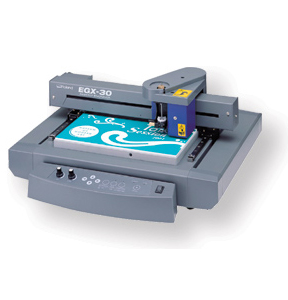CNC Engraving: Difference between revisions
From DT Online
mNo edit summary |
No edit summary |
||
| Line 10: | Line 10: | ||
[[Category:Secondary]] | [[Category:Secondary]] | ||
[[Category:Bench Top Equipment]] | [[Category:Bench Top Equipment]] | ||
[[File:3Dprinter.png|400px|right]] | |||
__TOC__ | |||
=====Description===== | |||
Most traditional manufacturing processes for single components is based on the removal ''(or subtraction)'' of materials for standrd bvar stockj for example ''(e.g. by drilling, milling or turning on a lathe for example)''. [https://en.wikipedia.org/wiki/3D_printing '''3D Printing'''] is the general term now used for '''Additive Manufacturing ''(AM)''''' which, by contrast, creates objects by a process of fusing together layers of material to build up a 3D product. | |||
=====Features and Applications===== | |||
A variety of '''Additive Manufacturing''' techniques have been developed ''(e.g. [https://en.wikipedia.org/wiki/Stereolithography '''Stereolithography'''], [https://en.wikipedia.org/wiki/Direct_metal_laser_sintering '''Direct Metal Laser Sintering ''(DMLS)''''' and even [https://en.wikipedia.org/wiki/Construction_3D_printing '''Construction 3D Printing''' which prints buildings with concrete!)'' but the method most commonly available for schools and hobbyists is based on building up a model from layers of a plastics filament and fusing them together ''(i.e. [https://en.wikipedia.org/wiki/Fused_deposition_modeling '''Fused Deposition Modeling''')'' in which a coil of plastics ‘wire’ is fed through a computer controlled heated nozzle. | |||
---- | |||
<span style="color: green">'''Note:''' | |||
Although school use of 3D printing may be limited to plastics and similar materials, models created in wax can then be used in a '''[[Lost Wax Casting]]''' process to create protoypes in metals such as Aluminium and various Zinc based alloys ''(e.g. Kayem or Mazac)''. | |||
</span> | |||
---- | |||
'''[[Injection Moulding]]''' can be less expensive when manufacturing large quantities of plastics products, but Additive Manufacturing is generally more flexible and less expensive when producing relatively small quantities or single protoypes - hence the alternative name of '''Rapid Prototyping'''. | |||
{{CNC Equipment Buyers Guide}} | |||
[[Category:Computer Controlled Equipment]] | |||
Revision as of 11:34, 13 August 2016
Engraving is the practice of incising a design on to a hard, usually flat surface, by cutting grooves into it.
Traditionally it was a hand process using small cutting tools called Burin and was how copper printing plates used to be made. Hand engraving is still used today by artist/craftsmen but most is now done using a CNC engraving machine.
CNC Engravers can be used as a mini-router or milling machine for small scale work in acrylic, close-grained timbers, manufactured boards, or softer metals. Models are available specifically designed for engraving electronic circuits using copper-clad board and some have a limited 3D capability.
Description
Most traditional manufacturing processes for single components is based on the removal (or subtraction) of materials for standrd bvar stockj for example (e.g. by drilling, milling or turning on a lathe for example). 3D Printing is the general term now used for Additive Manufacturing (AM) which, by contrast, creates objects by a process of fusing together layers of material to build up a 3D product.
Features and Applications
A variety of Additive Manufacturing techniques have been developed (e.g. Stereolithography, [https://en.wikipedia.org/wiki/Direct_metal_laser_sintering Direct Metal Laser Sintering (DMLS) and even [https://en.wikipedia.org/wiki/Construction_3D_printing Construction 3D Printing which prints buildings with concrete!) but the method most commonly available for schools and hobbyists is based on building up a model from layers of a plastics filament and fusing them together (i.e. [https://en.wikipedia.org/wiki/Fused_deposition_modeling Fused Deposition Modeling) in which a coil of plastics ‘wire’ is fed through a computer controlled heated nozzle.
Note: Although school use of 3D printing may be limited to plastics and similar materials, models created in wax can then be used in a Lost Wax Casting process to create protoypes in metals such as Aluminium and various Zinc based alloys (e.g. Kayem or Mazac).
Injection Moulding can be less expensive when manufacturing large quantities of plastics products, but Additive Manufacturing is generally more flexible and less expensive when producing relatively small quantities or single protoypes - hence the alternative name of Rapid Prototyping.
Safety Point!
- Fully enclosed machines with interlocks are advised for school use.
- Only Lasers with the laser beam totally enclosed should be used in schools and an interlock provided to prevent operation unless the laser is enclosed - check Laser Safety with supplier.
- Always isolate any CNC machine before adjusting tools or work piece and ensure hands are well clear of the table before switching on - when the program runs : the cutter will move!
 |
 |
 |
 |
 |
 |
 |
| GenMitzu CNC Router |
Trend CNC Machine Engraver |
GOWE CO2 Laser Cutting Machine |
Flashforge 3D Printer |
Sign Cutter Plotter |
Scanner |
Computerised Digital Sewing Machine |
